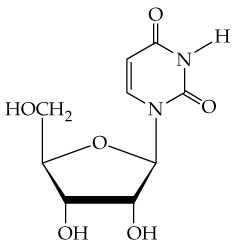 Back
BackProblem 1
Name the nucleoside shown here. Copy the structure, and number the C and N atoms (refer to Table 26.1).
Problem 5a
Write the full name of:
a. dUMP
Problem 6
Name the bases in the pentanucleotide with the sequence G-A-U-C-A. Does this come from RNA or DNA? Explain.
Problem 8a
Write the complementary sequence of bases for each DNA strand shown next.
a. 5′T-A-T-A-C-T-G 3′
Problem 9
Draw the structures of adenine and uracil (which replaces thymine in RNA), and show the hydrogen bonding that occurs between them.
Problem 10
Is a DNA molecule neutral, negatively charged, or positively charged? Explain.
Problem 11a
DNA and RNA, like proteins, can be denatured to produce unfolded or uncoiled strands. Heating DNA to what is referred to as its “melting temperature” denatures it (the two strands of the double helix become separated). Why does a longer strand of DNA have a higher melting temperature than a shorter one?
Problem 12
What are Okazaki fragments? What role do they serve in DNA metabolism?
Problem 13
What is the difference between DNA polymerase and DNA ligase?
Problem 14
What is the function of the spliceosome in hnRNA?
Problem 15a
What mRNA base sequences are complementary to the following DNA template sequences? Be sure to label the 5′ and 3′ ends of the complementary sequences.
a. 5′ CAT GCT CTA CAG 3′
Problem 16a
List possible codon sequences for the following amino acids.
a. Val
Problem 17
Identify the amino acid for which the codon GAG codes, and what other codon could encode for this same amino acid?
Problem 18a
What amino acids do the following sequences code for?
a. AUC
Problem 20
What amino acid sequence is coded for by the mRNA base sequence CUC-AUU-CCA-UGC-GAC-GUA?


